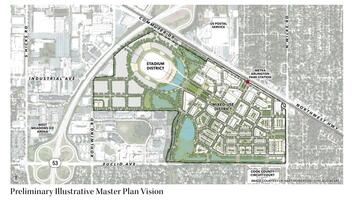
Suburban urbanism is making another cameo appearance.
As most followers of cities know, the lack of housing affordability in large cities, combined with the impact of the rising work-from-home phenomenon since the start of the Covid pandemic, has provided a powerful one-two punch to cities that has caused many urbanists and suburbanists alike to question the long-term viability of downtowns. Suburbs have been stepping in to fill the void.
Chicagoland is home to one of the latest iterations of the genre. The Chicago Bears are moving forward with plans to relocate to suburban Arlington Heights, IL, on the site of the former Arlington Park horseracing track. The 300-acre site would accommodate not only a new retractable dome stadium, but an entertainment complex, hotels, a performance venue, offices, thousands of townhouse and multifamily housing units, and parkland. The site would be served by commuter rail from downtown Chicago. The Bears' new home would be a similar sports-oriented concept to Sofi Stadium in Inglewood, CA near Los Angeles and The Battery Atlanta complex that includes Truist Park in unincorporated Cobb County, north of Atlanta.
Suburbs have been yearning for some of the same development action that downtowns have been gaining for years, with varying levels of success. Their goal? Become mixed-use destinations that offer greater appeal to a wider audience.
Ever since the advent of New Urbanism in the '80s, the spread of planned mixed-use developments in the '90s and the emergence of lifestyle centers in the 2000s, suburban developers have been trying to bring more of the urban experience to suburbia. Whether it was the walkability of pre-auto developed neighborhoods, the vibrancy and energy of shopping and entertainment districts, suburbs have been trying to replicate cities for some time.
Why do I say with varying results? Mostly because suburban districts like these have tried to incorporate the mixed-use component from the outset. When all uses of a mixed-use development are in demand, suburban versions of the theme can be immediately successful. But if the demand for housing, or commercial development, is waning, for example, it could put the entire development in jeopardy.
There's a reason for this. Downtowns built up incrementally, over decades. They usually started as regional marketplaces that later became larger commercial hubs. As office work grew in prominence, they became the premier location for high-rise office buildings because of their regional centrality. Later, the combination of shoppers and workers made downtowns ideal places for entertainment and experience - bars, restaurants, theaters, sports venues, parks, museums, and the like. Most recently, all these aspects have made downtowns desirable living places to people who want to be at the center of lively activity.
It's fair to say that suburbs, particularly the post-1960's/'70s versions, emerged as the city remedy. Cities were crowded and dirty? Suburbs were spacious and clean. Cities were plagued with high crime and poor schools? Suburbs had low crime and excellent schools. Many suburbs were created explicitly as the alternative to cities, and offered a quieter, more relaxed and family-oriented environment.
But the traditional family structure isn't as prevalent as it used to be in America, and many suburbs have reached a plateau because of that. Household size continues to decrease. There are more single-person households than ever. There are fewer children to fill expensive schools. People are getting older, staying in place and not necessarily turning their homes over to a declining next generation of families. Families continue to get smaller. There's still plenty of supply of family-oriented suburbia out there in metropolitan America, but demand has declined somewhat. That's caused suburbs to expand their horizons.
Read the rest of this piece at Corner Side Yard Blog
Pete Saunders is a writer and researcher whose work focuses on urbanism and public policy. Pete has been the editor/publisher of the Corner Side Yard, an urbanist blog, since 2012. Pete is also an urban affairs contributor to Forbes Magazine's online platform. Pete's writings have been published widely in traditional and internet media outlets, including the feature article in the December 2018 issue of Planning Magazine. Pete has more than twenty years' experience in planning, economic development, and community development, with stops in the public, private and non-profit sectors. He lives in Chicago.
Photo: courtesy Corner Side Yard Blog.













Mixed use suburban
Here in Minneapolis area there have been many attempts at mixed use with mostly failed results. Wayzata Bay as well as West End St. Louis Park are both over a decade old, yet retail fails to get leased. Excelsior at Grand shops come and go, and many of the mixed use apartments above commercial built two decades ago still have 'for lease' signs on the retail level. My wife took a ULI Class and the guest speaker, a banker said they will no longer finance such developments. Partially these failures can be because we have 6 months terrible weather, but I attribute these failures on the incredibly inconvenient parking to access shops. Wayzata Bay is a beautiful development over a decade old in a perfect location - yet I'd guess 80% of the retail has never been leased. West End, the restaurants do good, but the retail has been a merry-go-round of constant failures. Ramsey Town Center is a mishmash of architecture and much of the residential has a cheapness about it. Clover Ridge commercial is a joke... the coffee shops and restaurants never materialized and instead used clothing stores. I have yet to see a successful 'town center' development yet at least in this area.
Stadiums
First came the suburban wave with big parking lots in the '70s-80s. Then the return to urban cores. Now again to the inner 'burbs, with mixed use. And better order?